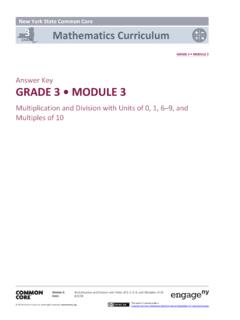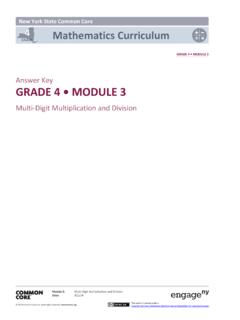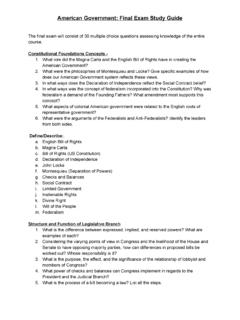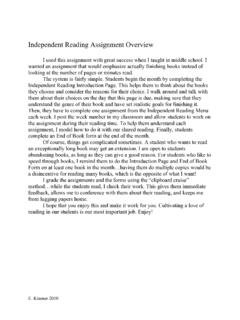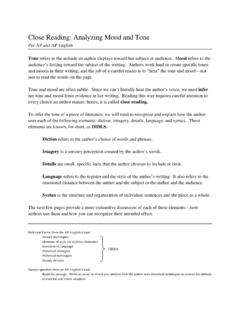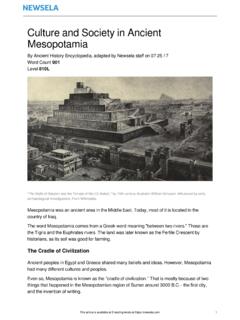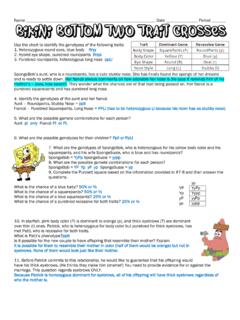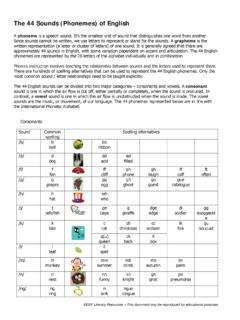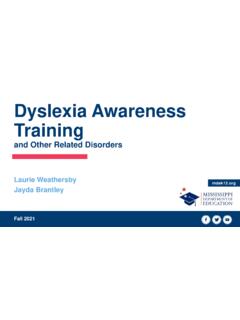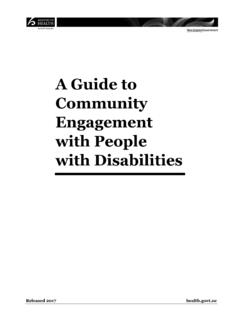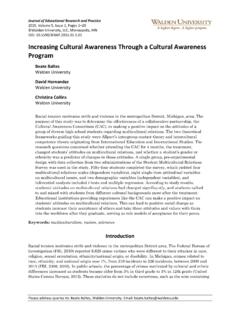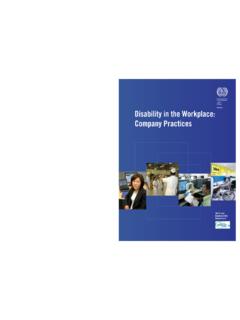Transcription of Disability Awareness Activity Packet
1 Disability AwarenessActivity Packetby Bev Adcock and Michael L. RemusActivities and Resources for Teaching Students About Disabilities 2006 Possibilities, booklet gives you some ideas for helping students understand different disabilities. Keep in mind that two people can have the same Disability and still be very different. You may also have students who have some of the disabilities described here, but are not at all similar to what is de-scribed. That is not uncommon. Not all blonde 4th graders are alike either!You may need information on disabilities that are not listed here. If that happens, please contact your Special Education Department for more ideas and check the list of resources in the back of this booklet. Warning! Unless you have permission in writing from a student s parents, it is illegal for you to tell anyone about a student s disabilities or even that they have a Disability .
2 Some families may be will-ing to do this, while others will not. We suggest using these activities to talk about disabilities in a general way and build understand-ing. Many of the activities can be used to explain more than one Disability . The Activity for Autism for example, could also be used to illustrate Attention Deficit/Hyperactivity Disorder (ADHD). The problems with being unable to concentrate are similar. people with cerebral palsy might be in a wheelchair or have problems with their hands as described under Physical Disabilities and also have problems speaking clearly as described under Communication Disorders. If you don t find the exact Disability you are looking for, think instead of the problems it applaud your efforts to educate all students. We hope you find the material helpful. Bev Adcock & Michael L. RemusDedicated to all the kids who live it every day and succeed anyway 2006 Possibilities, need your feedback!
3 We want to make sure this booklet meets your needs. Please answer the fol-lowing questions and return the form to:Lidia VittoreDVUSD Special Education 20402 N. 15th Avenue Phoenix, AZ 85027 Email: What was helpful?2. List anything that needed more If any of the activities were unsuccessful with your students, please de-scribe the Would you use these activities again next year? q Yes q NoIf no, why not? you have suggestions for changes or additions to this booklet?Thank you! 2006 Possibilities, Inc. Topic Disorders ..5 Hearing Impairments ..6-7 Learning Disabilities ..8-9 Intellectual Disability .. 10-13 Physical Disabilities ..14 Vision Impairments ..15-16 Disability in the Resources ..18-23 ContentsWarning! It is illegal to give out any information about a student without written permission from his/her parents. 2006 Possibilities, ! It is illegal to give out any information about a student without written permission from his/her parents.
4 AutismAutism is a developmental Disability that usually appears during the first three years of life. The cause is unknown. It affects how a person s brain works, but not all people with autism are affected the same way. When a person has autism, they may have problems:letting you know what they want;thinking;understanding what other people say or want;ignoring sounds;ignoring things or people that are moving;ignoring lights;being touched;understanding social rules;showing affection;controlling their feelings;knowing how to play with other kids; anddealing with is a spectrum disorder. That means that not everyone with autism has all the problems. One person may have three of the problems listed while another person has only one. Some people with autism struggle to learn. Other people with autism are very smart and can do complicated math when they are 3 years old. Some people with autism have trouble being touched while others like to hug.
5 Many people with autism like to do things in the same order all the time and have things arranged the same way. This helps them stay people with autism have a very hard time ignoring noises, especially if they are upset or in a new situation. They may try to calm themselves by rocking, moaning, talking loudly or even screaming. The moaning, talking or screaming helps them drown out the other noises so they can calm down. They may also try to go under a desk or in a small, dark place where they feel safer. Activity 1 This Activity is designed to show how people with autism are bothered by things most people don t notice. people with autism are often extra sensitive to noise, movement and even things like background noises most of us don t notice. Remember, not everyone with autism has these the class into groups of 5. Explain that they will each have a job to do. Go over their jobs and tell them they will start when you give the student in each group will play the part of someone with autism.
6 The other 4 people each have different jobs:Person #1 - You will play the part of a person with autism. Your job is to try and listen to what Person #5 is reading to you so you can take a test on the material. Try to ignore everyone #2 - Stand behind the student playing the part of someone with autism. Rub the edge of an index card (or piece of cardboard) against the back of their neck. You do not need to rub hard, but keep doing it over and over. Person #3 - Grab a book (any book will do), lean close to Person #1 and read in a loud voice the entire time. Person #4 - Pat Person #1 on the head and shoulder the entire time. Person #5 - Using a normal voice, read a paragraph to Person #1 then ask them questions about what you read. Do NOT try to drown out the other noises. Have all the students take a turn being Person #1 before you discuss it. How did it feel to be have so much commotion going on?
7 Did it make them want to scream or get away? Were they able to concentrate on the paragraph being read? What might have helped? 2006 Possibilities, ! It is illegal to give out any information about a student without written permission from his/her parents. Communication DisordersCommunication disorders are disabilities that keep a person from being able to speak or makes their speech understood. This can be caused by many different disabilities or people with difficulty speaking may use sign language , gestures or small pictures they carry with them. Activity 1 - Different wordsIf you have students in your class who speak a different language , have them stand in front of the class and say one sentence in their language . Have the class try to guess what was said. If you have more than one student who speaks the same foreign language , have them carry on a short conversation. Then have the class try to decide what was how it feels to not be able to understand something.
8 How quickly did the class give up? What are some other ways they could have tried to communicate? How is this similar to people with disabilities who can talk but are hard to understand? Activity 2 - No wordsWrite a simple sentence on a piece of paper, for example, The cat sat on a hot tin roof. Show this sentence to 1 student. The student must let the rest of the class know the sentence without writing, speaking or using any letters of the alphabet. Discuss:Was it difficult to communicate using this method? What would have helped? How can we communicate with someone who can t talk back? How can we help them communicate?If you want to give more students a chance to try this Activity , here are some suggested sentences:I feel want a lost my parents are getting a foot want a hamburger for m allergic to hate ketchup. 2006 Possibilities, ! It is illegal to give out any information about a student without written permission from his/her parents.
9 Hearing impairments include everything from not being able to hear certain sounds to being totally deaf. In most cases, a hearing loss doesn t simply mean that sounds are not loud enough. It usually means that sounds are garbled or unclear. A hearing aid may make speech louder, but usually will not make speech 1 - Not being able to hearYou need:a pair of foam ear plugs for each student a radio, TV, fan or anything else that can make white noise What to do:Show students how to put in the earplugs .Put on the white noise . If using a TV, put it on a station with no reception and turn up the volume loud enough to be distracting. If using a radio, set it between stations so you only hear static. If using a fan, turn it up on high. Read a long newspaper article or book passage. Read rapidly, using a soft voice, mumbling monotone, runing words together and pausing in odd places. Ask students 5 questions about the content of what you read.
10 Continue talking quickly in a soft, mumbling ear plugs, turn off white noise and discuss (in a normal voice) how not being able to hear clearly 2 - Lip-readingInstructions for teacher: Divide the class into pairs. One of each pair is A, and the other B. Give them the relevant instructions (page 7) and briefly explain the exercise. They should not see each other s instructions. Have them take turns lipreading, while their partner reads (moving their lips but making no sounds) a list of words or sentences. In their pairs, they should: say each word or phrase once only; go through the whole exercise before they tell each other the answers; when they finish discuss what they learned about lipreading; andreturn to the main group to share their ideas. Discussion: Allow 15 minutes for the exercise in pairs, then have everyone return to the main questions like:How successful were you at lip-reading?
